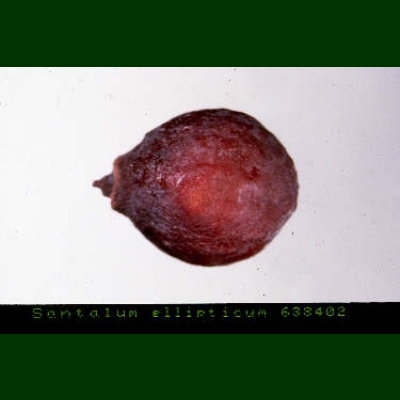 Hawaiian Name(s): ‘iliahi
Hawaiian Name(s): ‘iliahiScientific Name: Santalum (4 species)
Vernacular Name: sandalwood
Family: Santalaceae
Status: endemic
Authority: S. ellipticum Gaudich., S. freycinetianum Gaudich., S. haleakalae Hillebr., S. paniculatum Hook. & Arn.
Description: Shrub/tree, to 15 m.
Habitat S. ellipticum in many habitats, ridges, slopes, lava fields, rocks, of dry shrublands and forest 0–560 (–950) m, formerly on all main islands, S. freycinetianum mesic to wet forest, also dry forest (250–) 400–650 m (Kaua‘i, O‘ahu, Moloka‘i, Lāni‘i, Maui), S. haleakalae dry slopes of aloine shrublands (1800–) 1900–2700 m (Haleakala, Maui), S. paniculatum dry woodlands on lava/cinder substrate, to upper elevation wet forest or secondary ‘ohi‘a forest 450–2000 m (Hawai‘i) (Wagner et al. 1990:1220–1222).
Medicines: For dandruff and hair nit treatments, leaves and bark of the ‘iliahi are combined with naio ashes (Myoporum sandwicense). For some venereal diseases, ‘awa (Piper methysticum) is combined with wood shavings of ‘iliahi, nioi (Eugenia reinwardtiana), ‘ahakea (Bobea spp.), and kauila (cf. Alphitonia ponderosa). For severe sores, ‘iliahi, manena (Melicope hawaiensis), and ‘ahakea shavings are combined with ‘awa, and ‘ōhi‘a ‘ai bark (Syzygium malaccense) (Chun 1994:102–104).
Non Medicinal Uses: Wood called la‘au ‘ala (fragrant wood). Traditionally the powdered heartwood was used for perfume that was sprinkled on kapa (Degener 1930:145); the wood was used for musical instruments (Krauss 1993:80). In the historic period sandalwood was harvested for use in China for carved objects, chests, and incense, from about 1791-1840, peaking 1815-26 (Cuddihy and Stone 1990:38). In the Ethnology Collection at Bishop Museum there is a post-contact example of the wood made into a bowl.
Specific gravity of wood: unknown
Famous Locations:
Mele: "Ka wai ‘ula ‘ili ahi" line in "Kokohi" which could alternatively be understood as speaking of ‘iliahi. (Elbert & Mahoe 1970).
`Ōlelo Noeau:
Dye Color and Parts:
Kino lau:
Location on Bishop Museum Kalihi Campus:
Propagation Information: Intermediate. Extract seeds from ripe fruit, air dry 1 week, soak in .05% gibberallic acid for 5 days, change solution daily, dust with 1:1 powder sulfur:Captan; transfer to indivudual pot of 1:1 fine cinder/vermiculite after good root develops; only cut weed around plant (Bornhorst 1996:67–69; Culliney and Koebele 1999:64–68).
Hawaiian Native Plant Propagation Database.
Native Plants Hawaii.
Seed: Seed length approximately 8 mm. Photograph: H.Lennstrom Species: S. ellipticum.

Microscopy
Cross Section: Field of view: 2.6 mm x 1.6 mm. Photograph: H.Lennstrom. Species: S. paniculatum.

Radial Section: Field of view: 2.6 mm x 1.6 mm. Photograph: H.Lennstrom. Species: S. paniculatum.

Tangential Section: Field of view: 2.6 mm x 1.6 mm. Photograph: H.Lennstrom. Species: S. paniculatum.

